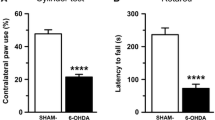Summary
Previous studies have provided evidence for the prime importance of newly synthesized dopamine as compared with the large endogenous stores of amine in the functional mobilization of dopamine under conditions of a heavy demand on the neuron such as in the presence of a neuroleptic. The present study was designed to examine the role of storage granules in the utilization of newly synthesized dopamine and to examine the mechanism of the cataleptic action of reserpine-like drugs.
It was found that the injection of a small dose of L-Dopa did not reverse the catalepsy produced by the short-acting dopamine depleter, Ro 4-1284, either when the depleter was given alone or was given after tyrosine hydroxylase blockade byα-methyltyrosine, provided that the L-Dopa was given at a time when Ro 4-1284 was present. However, the same dose of L-Dopa quickly reversed catalepsy when given at a time of dopamine depletion but in the absence of Ro 4-1284. Sinceα-methyltyrosine alone does not produce catalepsy until exhaustion of the large endogenous dopamine pool, but quickly potentiates neuroleptic-induced catalepsy, it is suggested that under normal conditions the slow transfer of stored dopamine to a releasable site is sufficiently rapid to maintain striatal function. However, the transfer rate appears to be too slow for adequate mobilization of the store under conditions of a heavy demand. It is further suggested that a prime role of storage granules is to channel newly synthesized dopamine into the synaptic cleft. Reserpine-like drugs appear to produce catalepsy, not by depletionper se of the main dopamine pool, but by interference with this granule channeling function.
Similar content being viewed by others
References
Andén, N.-E., Roos, B.-E., Werdinius, B.: Effects of chlorpromazine, haloperidol and reserpine on the levels of phenolic acids in rabbit corpus striatum. Life Sci.3, 149–158 (1964).
Bartholini, G., Haefely, W., Jalfre, M., Keller, H. H., Pletscher, A.: Effects of clozapine on cerebral catecholaminergic neurone systems. Brit. J. Pharmacol.46, 736–740 (1972).
Besson, M. J., Cheramy, A., Gauchy, C., Glowinski, J.: In vivo continuous estimation of3H-dopamine synthesis and release in the cat caudate nucleus. Naunyn-Schmiedeberg's Arch. Pharmacol.278, 101–105 (1973).
Carlsson, A., Lindqvist, M., Magnusson, T.: 3, 4-Dihydroxyphenylalanine and 5-hydroxytryptophan as reserpine antagonists. Nature180, 1200 (1957).
Goldberg, H. C., Broch, O. J.: On the mode of action of reserpine on dopamine metabolism in the rat striatum. Eur. J. Pharmacol.13, 155 to 167 (1971).
Juorio, A. V., Vogt, M.: The effect of prenylamine on the metabolism of catecholamines and 5-hydroxytryptamine in brain and adrenal medulla. Brit. J. Pharmacol.24, 566–573 (1965).
Kuruma, I., Bartholini, G., Tissot, R., Pletscher, A.: Comparative investigation of inhibitors of extracerebral dopa decarboxylase in man and rats. J. Pharm. Pharmacol.24, 289–294 (1972).
Murpurgo, C.: Antiparkinson drugs and neuroleptics. In: Progress in Brain Research: Horizons in Neuropsychopharmacology (Himwich, W. A., Schade, J. P., eds.), Vol. 15, pp. 121–134. New York: Elsevier. 1965.
Neff, N. H., Costa, E.: The influence of monoamine oxidase inhibition on catecholamine synthesis. Life Sci.5, 951–959 (1966).
Papeschi, R., Randrup, A.: Catalepsy, sedation and hypothermia induced byα-methyl-p-tyrosine in the rat. An ideal tool for screening of drugs active on central catecholaminergic receptors. Pharmakopsychiat.6, 137–149 (1973).
Pletscher, A., Da Prada, M., Burkard, W. P., Tranzer, J. P.: Effects of benzoquinolizines and ring-substituted aralkylamines on serotonin metabolism. Advanc. Pharmacol.6 B, 55–69 (1968).
Quinn, G. P., Shore, P. A., Brodie, B. B.: Biochemical and pharmacological studies on Ro 1-9569 (tetrabenazine), a non-indole tranquilizing agent with reserpine-like effects. J. Pharmacol. Exp. Therap.127, 103–109 (1959).
Sears, E. S., Shore, P. A.: Evidence for a prime role for newly synthesized dopamine in mesolimbic dopamine areas. J. Pharm. Pharmacol.27, 718–720 (1975).
Shore, P. A., Dorris, R. L.: On a prime role for newly synthesized dopamine in striatal function. Eur. J. Pharmacol.30, 315–318 (1975).
Author information
Authors and Affiliations
Additional information
Supported by USPHS Grant MH-05831.
Rights and permissions
About this article
Cite this article
Shore, P.A. On the role of storage granules in the functional utilization of newly synthesized dopamine. J. Neural Transmission 39, 131–138 (1976). https://doi.org/10.1007/BF01248771
Received:
Issue Date:
DOI: https://doi.org/10.1007/BF01248771




